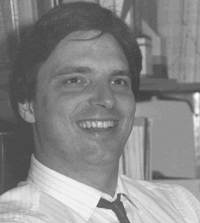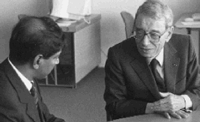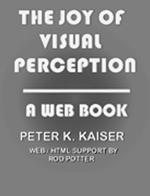
|

|
|
|
|
| | VOLUME 29, NUMBER 31 | WEDNESDAY, MAY 5, 1999 | ISSN 1199-5246 | | |
|
|
|||||||||||||||||||
|
|
By Susan Scott A new study of the Supreme Court of Canada's constitutional cases by York University's Osgoode Hall Law School suggests the court has not struck down as many laws as previously assumed. Patrick Monahan, law professor at York and director of the York University Centre for Public Law and Public Policy at Osgoode Hall Law School, examined the Supreme Court of Canada's constitutional cases handed down in the 1998 calendar year, and compared them with decisions released over the past few years. The analysis of rulings from 1996 to 1998, shows that in 76 cases involving the Charter of Rights and Freedoms, the court struck down legislation in 12. "Our findings indicate that the Supreme Court has not been cutting a large swath through the federal and provincial statute books," says Monahan. "The court has forced politicians to rewrite laws in only a handful of recent cases, and the court has usually given guidance as to how the legislation could be rewritten to conform to constitutional requirements." One significant exception was last year's decision in which Alberta teacher, Delwin Vriend, persuaded the Supreme Court to strike down the province's human-rights code. The court amended the code to include basic protections based on sexual orientation. Aside from the Vriend case, though, there is little evidence, says Monahan, of judicial activism in the 12 cases. In another ruling over which critics argued unsuccessfully for the use of the "notwithstanding clause" (used to override adverse rulings), the Supreme Court ruled that legislation rolling back the salaries of provincial court judges in Alberta, Manitoba and Prince Edward Island was invalid because it interfered with judicial independence. The court also ruled that each province must establish a commission to recommend provincial court judges' salaries. Monahan says the commissions' recommendations will likely lead to somewhat higher judicial salaries over the medium- to long-term. The complete study was released to more than 100 lawyers (including legal advisors from the federal and provincial governments), and academics at the annual Osgoode Hall Constitutional Cases Conference last month in Toronto. Monahan explains it's the third year that Osgoode has conducted a review of Supreme Court cases, and the second year for the conference. "Ours is the only event of its kind in the country that compiles a critical analysis of Supreme Court cases," he says. Some cases in which the Supreme Court declared statutes unconstitutional 1996-98: 1996
1997
1998
|
||||||||||||||||||
|
|
University receives another three Canadian Foundation for Innovation awards By Susan Scott All three applications submitted by York University research teams have received funding through the most recent funding opportunity of the Canadian Foundation for Innovation's (CFI) Institutional Innovation Fund. The successful projects are: * the Centre for Vision Research (CVR), submitted by Laurence Harris, psychology professor, * the Centre for Research in Earth and Space Science (CRESS), led by Gordon Shepherd, director of CRESS, and * the Core Molecular Biology Facility, led by Ron E. Pearlman, Core Facility director. The recent funding announcement is part of an overall investment of more than $131 million to support 78 infrastructure projects in 33 Canadian universities and research institutions. CFI is an independent, non-profit corporation and was established in 1997 by the federal government to address the urgent need of Canada's research community in new, state-of-the-art research infrastructure. Last year, during the first round of competition in several disciplines, York's three applications to the competitions for which it was eligible were successfully awarded funding. Once the first round was completed, CFI selected a number of proposals to proceed to this second round of the competition in the Institutional Innovation Awards for which York received its three awards. CFI's mandate is to increase the capabilities of Canadian universities, colleges and other not-for-profit institutions to carry out important world-class scientific research and technology development. To implement its mandate, the Foundation, in cooperation with funding partners, provides capital funding for research and development.
|
||||||||||||||||||
|
|
A state-of-the-art laboratory for York's Centre for Vision Research in the new Computer Science Building will be built thanks to funding from the Canadian Foundation for Innovation's Institutional Innovation Fund. Harris says the CFI funding is the latest in a series of grants to the CVR aimed at strengthening its position as an international research centre of excellence in vision and motor processes, perception and computer vision. Earlier this year for example, the CVR received a grant from the Ontario Research and Development Challenge Fund (ORDCF) to establish a Chair in Computational and/or Biological Vision at York. The new lab will, for the first time, bring together 16 researchers from several university departments under one roof including computer science, biology, and psychology, explains Laurence Harris, psychology professor and coordinator of the CFI funding proposal. "Our work is increasingly becoming more intertwined," explains Harris. "Previously, we were spread literally throughout the campus. Now, we will be able to work more efficiently together." The centrepiece of the lab will be a super-computer from SGI (Silicon Graphics Inc.), a major corporate partner on the project. Harris says SGI is a leader in the manufacturing of this type of distinctive computer because of specialized graphic rendering and sound generation hardware and York is fortunate to acquire one of these mammoth machines one of only a handful in operation throughout North America. Its huge memory means more power to run a complex job so that scientists can get their results faster. Basically, the new lab will allow researchers to use virtual reality environments as a scientific tool to investigate different sensory processes, says Harris. Researchers will be able to study both human and animal perceptions to simulated (virtual reality) situations. For example, one of the components of the lab, Cave Automated Virtual Environment (CAVE), looks like a cave, says Harris. It's really a controlled environment in which people sit while they're introduced to various visual stimuli, and their reactions to the stimuli are studied. "We will be able to see how people visually perceive what is happening around them, and then how they visually perceive their actions to the stimuli," says Harris. Other equipment in the new lab will test animal and human reactions to sounds and motion. Harris explains "we're really interested in how the brain works" and this new equipment will help them. Beyond that, researchers are hoping to apply that knowledge to real-world situations. These include developing virtual-reality training devices for astronauts; studying disorientation and the factors that allow people to orient themselves (to know their position in relation to their surroundings knowing which way is up); studying why trainee pilots become disoriented and fly their planes into the ground, and experienced pilots become disoriented during times of poor visibility such as bad weather; and studying why astronauts suffer from disorientation and space sickness.
|
||||||||||||||||||
|
|
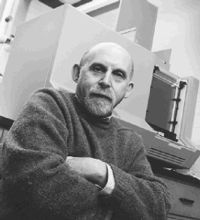
The Core Molecular Biology Facility has operated at York for almost five years. The Canadian Foundation for Innovation's Institutional Innovation Fund grant will allow the Core Facility to expand its research and research capabilities. A proposal for CFI funding was submitted jointly by Ron Pearlman, biology professor, and his colleagues in the chemistry department, professors Michael Siu and Michael Organ. All are part of the Faculty of Pure and Applied Science at York. "The Core Facility began its work on DNA sequencing only, now our plan is to expand into other emerging technologies," explains Pearlman. "This means we will be able to expand our services and better serve the scientific communities." DNA encodes the heritage of a living creature and DNA sequencing is the core of the science called genomics writing down all of the genes of a living creature. Specifically, the Core Facility will focus on three main research areas: genomics - DNA sequencing and mapping; proteomics the identification and sequencing of proteins, and the study of protein structure and modification; and combinatorial chemistry the synthesis of large numbers of compounds simultaneously, an approach used to speed up the process of drug discovery. "This project is an important example of inter-disciplinary, inter-departmental collaboration," says Pearlman. Chemistry, biology, pure and applied science, pharmaceutical and instrumentation companies are all working together. The other key partner in the project is Perkin-Elmer Companies, based in Mississauga. Perkin-Elmer manufactures the instruments the Core Facility uses. "They are a major company in this area, and we're fortunate they have chosen to work with York," Pearlman states. "In addition to our students being able to work with their people, one of the benefits to the company is that they have a place to display their instrumentation." The fields of genomics, proteomics, and combinatorial chemistry are key to developments in all areas of the life sciences including biomedical science, and the pharmaceutical industry in drug design and development. The three fields make an important contribution to understanding the origins of many diseases including heart disease and cancer, to diagnosis, and to development of approaches to treatment. With a basic understanding of genetics and cell and molecular biology using the tools of genomics and proteomics, new therapeutic agents can be designed, synthesized and tested using the approaches of combinatorial chemistry. Developments in agriculture such as crop improvements are also dependent on genomics and proteomics, which will be very important in efforts to increase the food supply. Besides providing a significant ability to enhance research at York, the DNA sequencing component of the facility, directed by Lab Manager Lee Wong, contributes important services far beyond the university. Pearlman says right now the Core Facility supplies much of the DNA sequencing for other academic institutions and hospital research institutes including the University of Toronto, and for many private sector companies, such as Pioneer Hi-Bred International, one of the largest seed producing companies in the world. Genomics and DNA sequencing provide an example of research capability that will lead to improved human health and quality of life, and preservation of the environment. Moreover, support for graduate students includes introducing them to important research. The potential for biomedical applications in genomics, proteomics and combinatorial chemistry is enormous, and training using state-of-the-art equipment and techniques is essential for students' future careers in these fields.
|
||||||||||||||||||
|
|
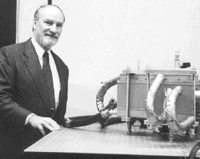
CRESS Director Gordon Shepherd with the Stratospheric Wind Interferometer For Transport (SWIFT), developed by CRESS, which is designed to measure winds in the stratosphere York's Centre for Research in Earth and Space Science (CRESS) has received funding from the Canadian Foundation for Innovation through its Institutional Innovation Fund to set up a new Space Instrumentation Laboratory in which to build better instruments for the observation of the Earth's atmosphere from space. The data gleaned from space observations will be incorporated into models which will strengthen our understanding of weather and climate, and contribute to the solution of ozone depletion and global warming. "For the first time, it will mean our students will be working on a space project right from the beginning," explains Gordon Shepherd, CRESS director. "It will provide a useful environment for students to work on the background development and not just on a project that has already started." The CFI funding also allows for renovation of CRESS's space in the basement of the Petrie Science Building. The area is large, says Shepherd, and the renovation will allow more efficient use of the space. "While CRESS has been active in space research in the past, it has never been able to acquire adequate facilities under its existing programs," explains Shepherd. "This CFI funding will put CRESS space activity on firm footing for the first time." Space science in Canada is conducted through missions proposed by university scientists and competitively selected for flight by the Canadian Space Agency (CSA). The CFI funding will allow York University activity to be much more closely integrated into the CSA program than in the past. Shepherd explains that CRESS will build the prototypes for the satellite instruments in the new lab, and its corporate partners, such as EMS Technologies, will build the actual flight instruments to be used on missions. "These types of partnerships are essential and we have worked effectively with EMS Technologies previously," says Shepherd. "They firmly believe that their ability to develop future products depends very much on the new ideas generated through the kind of activity CRESS does. We also benefit because we have access to the latest technological advances, and challenging career positions for our graduates." York is unique in Canada because it offers both undergraduate and graduate programs in space science. Students in the graduate program will be able to complete theses - both MSc and PhD - on space projects conducted in this new laboratory, says Shepherd. Students in the undergraduate program will also be involved with projects. |
||||||||||||||||||
|
|
By Paul Delaney It is hard to imagine living in a world without satellite communication, electronic mail and the Internet, to drive through a modern suburb and not see a satellite dish on someone's lawn. It is even harder to conceive a world without computers for better or for worse! Yet prior to 1957 there were no artificial satellites orbiting the earth, small computers were the size of a house and solid state technology was in its infancy. On Oct. 4, 1957, the world changed and entered a new era: the Space Age. Much to the surprise of everyone, the (former) Soviet Union launched into space Sputnik 1, an 83.6 kg aluminum sphere, 58 cm in diameter, bristling with four aerials. The satellite orbited the earth every 96 minutes and its only instrumentation was a beep-beep radio transmitter. Sputnik 1 re-entered the earth's atmosphere on Jan. 4, 1958. Despite its short flight, wheels had been set in motion that would irrevocably change the lifestyles of most of the peoples on our planet. Many satellites from both the United States and the Soviet Union followed Sputnik into orbit, many laden with instruments and some carrying animals. Despite the creation of NASA on Oct. 1, 1958, it was the Soviet Union that again stunned the world with its space technology. On April 12, 1961, Yuri Gagarin flew aboard Vostok 1 to become the first person to orbit the earth. He stayed in the weightless condition for 108 minutes. A human could eat and drink, indeed survive, in the new space environment. It would be another 10 months before John Glenn would repeat the performance for the United States. (As a piece of trivia, the only other space flight for Glenn occurred during 1998 aboard the Space Shuttle.) The 1960s saw an unprecedented number of space flights that swept technology along at a dizzying pace. Medical telemetry was improved, microelectronics were born, computer technology came of age, telecommunication satellites shrank the world, and of course, by the end of the decade, true to President Kennedy's commitment, humankind had walked upon the surface of the moon. During the 1970s an era of robotic exploration occurred and the frequency of human beings in space diminished. It was a time of planning and reflection for NASA, a period when the new space transportation system was designed. NASA committed itself to the exclusive use of the Space Shuttle for all of its planned activities. Satellites for earth orbit or exploration of the solar system would be deployed from the shuttle. In hindsight, this decision was not wise and to that end, NASA has recently adopted the philosophy of a mixed fleet of launchers, using the shuttle in concert with the more traditional expendable rockets. On April 12, 1981, the first shuttle, Columbia, thundered into the Florida skies. Another era of the space program and human exploration of space was beginning. It had been over 6 years since an American had flown into orbit. John Young and Robert Crippen guided Columbia through a two-day flight that was near perfect in execution. The new, very complex space-plane/glider captured the imagination of the world. Now many years later the shuttle fleet continues to pave an albeit rocky road into the high frontier now rendezvousing with the Russian Mir space station on a regular basis, exchanging crew and supplies, and transporting the beginnings of the International Space Station into orbit, another era in our space history. More recently, the exploits of fabled extra-solar planet hunters Marcy and Butler continue. Their technique of searching for distant planets by seeking out the delicate "wobble" of a star's spectrum, induced by the orbital motion of planets, has already yielded some 15 to 20 planetary systems. However, all these systems have shown only one planet in orbit, typically Jupiter-sized or larger. Now, a star by the name of Upsilon Andromeda (44 light years distant) has revealed itself to possess at least three planets. This marks the first such observation of a multiple planet system around a Sun-type star. Some three years ago, a single Jupiter-sized planet was found in a very close orbit to Upsilon Andromeda. Now, these two new planets are at distances from their star that are comparable to the orbits of Earth and Mars around our Sun. They are large planets about two and four times the mass of Jupiter respectively. Check out the www.skypub.com or http://www.cannon.sfsu.edu/~gmarcy/planetsearch/planetsearch.html sites for more information. Do not get excited about the possibility of life just yet. These planets are not likely earth-like in nature and given that Upsilon Andromeda is hotter than our Sun, the planetary conditions will not be hospitable. Their discovery though is yet another indication that planets are indeed quite common around stars and further, our ability to detect such planetary systems is indeed maturing. Please note that Public Viewing at the York Observatory continues through the month of May commencing at 8 pm. The usual astronomical fare will be served under the relatively warm skies of Spring. Special Astronomy Day activities are slated for May 19. Viewing for Astronomy Day will commence at 4 pm to allow everyone a good view of the Sun. At 7 pm, a special presentation by Paul Delaney entitled "Mars: The Exploration Continues" will take place in one of the classrooms adjacent to the Observatory (3rd floor Petrie building). More information will be available on the Information Line: (416) 736-2100 ext. 77773.
Paul Delaney is a senior lecturer in physics and astronomy at York University and Master of Bethune College.
|
||||||||||||||||||
|
|
By Cathy Carlyle
At a press conference in Lyons, France, Dr. Boutros Boutros-Ghali, secretary- general of L'Agence de la Francophonie and former secretary-general of the United Nations (right), talks with In the process of encouraging young entrepreneurship, York University is not only holding its own, but also is actively promoting ways of assisting people aged 21 to 40 to expand in the world of business. The business world referred to here is broad in scope, taking in developing, as well as developed, countries. Sujit Chowdhury, York University's executive-director of the Institute for Leadership Development, was this year's secretary-general and global coordinator of the 6th World Summit of Young Entrepreneurs. "We look at the Summit as the 'World Olympiad' for young entrepreneurs," he said with his typical enthusiasm. "It is held in the spirit of excellence with a commitment to human progress. It is a process, not a one-time event. We hold these summits every 18 months or so." The latest Summit took place last November in Lyons, France. The Summit itself is a part of a larger picture: the United Nations Conference on Trade and Development (UNCTAD). "Our aim is to facilitate the mechanism for joint ventures," said Chowdhury. "It is a marvellous opportunity for young entrepreneurs to interact with heads of international agencies and top exceutives from the government and private sectors. These people can come up with new ideas and policies from listening to young entrepreneurs tell them what is needed to facilitate ventures in a collaborative fashion." He added that another aim of the Summit is to provide participants with access to information and communication technology. "We see the sheer energy, the synergy that is being created. The participants are not trying to compete with each other, but collaborate", said Chowdhury. "They are not cut-throat. This is unlike big corporations. We are pleased that our Summit title prevailed: 'Partnering for Success in the Global Markets'. We are trying to help them invent markets together through joint ventures that are economically sustainable and environmentally sound, rather than take a share of the existing market. The organizers aimed to assist in building bridges between countries through engaging young entrepreneurs from all sectors of society. Our prime goal was to exercise diplomacy." One of the most innovative sessions during the Summit had the catchy title, "Let's Make a Deal: Entrepreneural Transactions on the Spot". As amusing as the name seems, it had a serious, underlying intent. Participants were pitching for the best partners, according to Chowdhury. Those who wished to take part gave a spiel about their business with the idea of gaining one or more people who wished to form a partnership. "They gave a pitch on a real venture, then chose one or two individuals. The whole idea was to assist communities and countries in economic pursuit through private sector inititiatives and development." Chowdhury felt that the first world Summit was "long overdue". Corporate executives can afford to travel and network, he pointed out, but young entrepreneurs cannot. It was an opportunity for those who aspire to grow internationally, not just through discussion but also through practical, hands-on training in such fields as trade negotiation and market speculation. "We involved the world's most creative and aspiring young entrepreneurs around the globe," he said. In the latest world Summit, there were 330 participants, nearly half of whom were women, from 117 countries, with proportionate representation from developing countries and from indigenous entrepreneurs. Participants were gleaned from nearly 5,000 organizations, industries and associations in 189 countries. A special welcoming note was delivered to the Summit delegation by Michael Stevenson, Vice-President (Academic Affairs) York University, and founding member of the Institute for Leadership Development.
|
||||||||||||||||||
|
|
Hoover House, May 1983. Built circa 1843 by Abraham Hoover (1821-1905), Hoover House is situated on the York Campus, southwest of Stong Pond. (York University photographic collection, York University Archives)
|
||||||||||||||||||
|
|
by David Finestone Buried Treasure! There's gold in that thar web...or so the WWWeb sages would have us believe. The maddening trouble is trying to find the gems in that glut of information. Serendipity is all too often the the most accurate search engine. But, then sometimes you find a site that will take you far. The York website stats page, www.yorku.ca/stats is an interesting enough site on its own, but as a serendipity engine it's York's best. So it is with great exuberance that I share the following site I came across through the stats page....
The Joy of Visual Perception: A Web Book at www.yorku.ca/eye/ by York Psychology Professor Emeritus Peter K. Kaiser (with help from York Webmaster Rod Potter), is an oasis of informative and visually stimulating order. The book is a visual cornicopia of figures and graphical representation of ideas and concepts linked to more detailed explanations and examples. All this, plus the "Fun Things in Vision" section create an excellent interactive teaching/
|
||||||||||||||||||
|
| Current Issue | Previous Month | Past Issues | Rate Card | Contact Information | Search |
|
